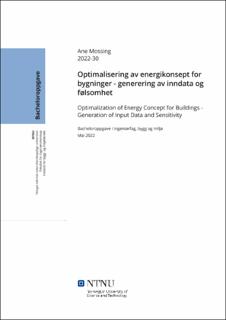| dc.contributor.advisor | Bohne, Rolf André | |
| dc.contributor.advisor | Wærnes, Elisabeth | |
| dc.contributor.author | Mossing, Ane | |
| dc.date.accessioned | 2022-07-05T17:20:41Z | |
| dc.date.available | 2022-07-05T17:20:41Z | |
| dc.date.issued | 2022 | |
| dc.identifier | no.ntnu:inspera:106805903:110161380 | |
| dc.identifier.uri | https://hdl.handle.net/11250/3002852 | |
| dc.description.abstract | Denne rapporten ser på hvordan valg av inndata påvirker lønnsomhet og miljøpåvirkning, for å finne det optimale energikonseptet for et bygg. Det ble satt opp tre ulike energikonsept som kan benyttes i et kontorbygg, hvor to av de baserer seg på bruk av varmepumpe og elkjel, og den tredje på fjernvarme og kjølemaskin. Det ble besluttet at vannbåren varme skulle benyttes som distribusjonssystem, og dermed ble bergvarmepumpe og luft/vann-varmepumpe aktuelle løsninger. De tre konseptene er omtalt som BergVP, LuftVP og Fjernvarme.
Det ble benyttet to ulike simuleringsverktøy for å finne forbruksprofiler; SIMIEN og PROFet. For å finne det forventede årlige energiforbruket ble et program utviklet av Multiconsult benyttet. Programmet brukes også for å se om det er lønnsomt å installere solceller på tak og fasade. Det gjøres LCC og LCA for å finne lønnsomhet og klimagassutslipp, dette ble gjort i Excel og One Click LCA. Videre ble det gjort følsomhetsanalyse for å se hvordan nåverdi endrer seg med økende strømpris, og hvordan klimagassutslippene for fjernvarme blir påvirket av valgt forbruksmiks. Mange av de nødvendige inndataene er basert på erfaringstall fra tidligere prosjekt i Multiconsult.
Det er store forskjeller i beregnet energibehov for de tre energikonseptene, avhengig av benyttet lastprofil. De beregnede lastprofilene fra PROFet var generelt dobbelt så store sammenlignet med lastprofilene fra SIMIEN. Den elektriske effekten var derimot fire ganger så stor. Dette medførte at det årlige energiforbruket for de tre energikonseptene med lastprofilene fra PROFet også ble svært store. Kun BergVP og LuftVP fikk positiv nåverdi i løpet av analyseperioden, mens Fjernvarme var negativ. Dette gjaldt med begge lastprofilene.
Strømpris ble variert opp til 2,4 kr/kWh. Dette ga nåverdi på 12 490 244 kr og 10 967 315 kr for BergVP_sim og LuftVP_sim. For Fjernvarme_sim ble verdien negativ, på 4 990 758 kr. For klimagassutslippene ble det kun sett på utslipp fra energikonseptene med lastprofil fra SIMIEN. Med valgt forbruksmiks for fjernvarme og elektrisitet var det små forskjeller. Følsomhetsanalysen for forbruksmiks viste derimot at valg av forbruksmiks påvirker resultatet i stor grad, og høyere forbruksmiks gir større utslipp.
Basert på resultatene er det tydelig at lønnsomhet og miljøpåvirkning fra de ulike energikonseptet er sterkt knyttet til valg av inndata fra forbruksprofil, strømpris og forbruksmiks. De store forskjellene i forbruksprofil viser at PROFet per dags dato ikke er optimalt å benytte for å finne lastprofil for ett enkelt kontorbygg med passivhusstandard. | |
| dc.description.abstract | This report is based on how different options of input data affects profitability and evironmental impact, to find the best energy concept for a building. Three different energy concepts for an office building were chosen, where two of these uses a heat pump and an electric boiler, and the third option uses district heating and a cooling machine. The chosen distribution system was waterborn heat, which makes a ground source heat pump and air-to-water heatpump the best solution. The three energy concepts are called BergVP, LuftVP and Fjernvarme.
Two different simulation tools are used to find load profiles, to be able to compare the two. The first tool is SIMIEN, which is a well used tool in Norway. The second one is a relatively new tool made by SINTEF, named PROFet. A tool developed by Multiconsult is used to find the annual energy consumption, as well as to check if it is profitable to install photovoltaics on the roof and facade.
Most of the input data is based on experience figures from previous projects in Multiconsult. LCC and LCA is done to find profitability and greenhouse gas emissions. These calculations are done in Excel and One Click LCA. Further, a sensitivity analysis including spot price and consumption mix for district heating were done, to see how the present value and greenhouse gas emissions changed with higher spotprice and different consumption mix.
There were big differences in the energy needs for the three energy consepts, based on chosen load profile. The load profiles from PROFet were in general twice the size compared to load profiles from SIMIEN. The electrical power were almost four times bigger. This led to high annual energy consumption for the energy concepts that used load profiles from PROFet. The present value were only positive for two of the options, only BergVP and LuftVP.
The energy concepts with load profiles from SIMIEN were used in the LCA. The results showed that there were only small differences in greenhouse gas emissions with the selected consumption mix for electricity and district heating. The sensitivity analysis pointed out that the selected consumption mix highly affects the results, which means that a higher consumption mix entails higher emissions.
Based on the results, it was concluded that the profitability and environmental impact from the different energy consepts are strongly linked to the choice of input data for load profiles, spot price and consumption mix. The differences in load profiles shows that PROFet is not the best option to use to find load profiles for an office with passive house standard. | |
| dc.language | nob | |
| dc.publisher | NTNU | |
| dc.title | Optimalisering av energikonsept for bygninger - generering av inndata og følsomhet | |
| dc.type | Bachelor thesis | |
